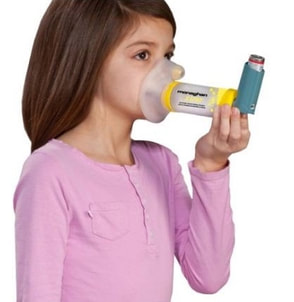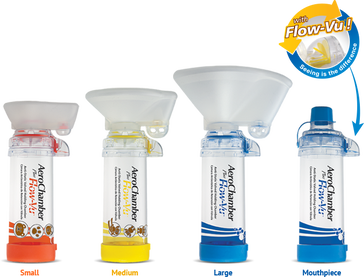BronchodilatorBronchodilators widen airways by helping the surrounding muscles relax. This allows more air to travel through the airways, which helps other medications work more effectively.
Bronchodilators are inhaled through a device that releases a specific amount of medication with each use (a metered dose inhaler). Less commonly, they can be taken through dry powder inhalers or nebulizers. They often come in handheld aerosol canisters. The inhaler may also include a spacer, a tube that attaches to the canister. A spacer prevents medication from being sprayed on the mouth and throat, so that more of it reaches your lungs. Ask a Care Team Member if you do not have a inhaler spacer. Always follow the instructions on the package of your inhaler unless your care team gives you different instructions. Typically, after shaking the inhaler, you squeeze it and it releases medication as you breathe in. Hold your breath for about five seconds before breathing out through your mouth. You should wait for 60 seconds before taking the second inhalation. A typical dose is two inhalations, but your care team may give you different instructions based on your specific health needs. |
- HOME
- RESOURCES FOR CF FAMILIES
- ABOUT US
- CF EVENTS
-
WHAT IS...
- Cystic Fibrosis
- Antibiotic Resistance
- Bronchodilator
- Chest X-Ray
- Home Spirometry
- Hypertonic Saline
- Inhaled Antibiotics
- Labs / Blood Work
- Mucus Thinners
- Oral Glucose Tolerance Test (OGTT)
- PEP Device
- Pulmonary Function Test (PFT)
- Pulmozyme / Dornase Alfa
- Sputum Cultures
- Sterilizing the WABI
- Sweat Test
- NEWS & UPDATES
HOME | RESOURCES FOR FAMILIES | CF EVENTS | NEWS & UPDATES | ABOUT US
|
Charlotte CF Families website and CF Family Advisory Board are operated by local CF families with the guidance of the Atrium Health Cystic Fibrosis Program. No advice or recommendations on this page should be taken above that of your CF Care Team. Every person with CF is different. The advice and suggestions on this page are simply a guide to help families feel connected and informed.
|
Last Published July 2024
Site Design by Rebecca Preslar |



